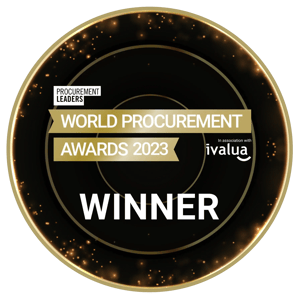The complexity of supply chains and market environments is increasing. Staying relevant within procurement today requires next-level adaptability. Speed is necessary to keep up with market changes and address evolving stakeholder needs.
Agile is widely adopted and applied within supply chains, borrowed from software development. Being agile means being able to think, adapt, learn, understand, move, and re-assess quickly.
Procurement is dynamic in nature, but often the way of sourcing and running RFPs can be perceived as time-consuming and outdated.
This blog post provides an overview of agile procurement principles and how agile sourcing can transform the processes and results of procurement.
What is Agile Procurement?
Agile procurement means becoming less process-driven, less governance oriented, and less orthodox.
As a philosophy, it is more collaborative, fast-paced, and open. Agile is about technical excellence, interpreting data, being open to new ideas, and empowering individuals to take ownership.
Agile procurement builds upon the principle of customer obsession and demonstrates customer value. The collaboration between all relevant stakeholders brings new ideas and leads to considering alternative solutions.
What is agile sourcing?
Agile sourcing is a collaborative alternative to the traditional sourcing process based on agile methodology, which can achieve higher-quality sourcing results.
Interaction with business units and management teams is frequent and happens on an interpersonal level. Early involvement of end-users and suppliers means a faster process and a better result.
Workshops and discussions can reduce the long process of drafting, reviewing, updating, and re-writing the scope of work before issuing an RFP.
Agile vs. traditional sourcing
Traditional and agile teams ultimately aim for the same result – a successful sourcing result. However, traditional sourcing uses slow legacy policies and processes involving pre-defined routine steps, heavy governance, safeguards, and extensive tracking.
Traditional sourcing may be time-consuming and frustrating for multiple stakeholders, while procurement only tries to safeguard company interests, ensure that mandatory requirements are met, and mitigate risks. The process steps are linear, starting from identifying the need, creating a sourcing plan, issuing an RFP, and signing negotiations and contracts.
End-users tend to over-specify technology products and services. Therefore, in agile sourcing, supplier discussions occur earlier and more frequently in the agile approach. Agile sourcing allows for changes in scope during the sourcing process. Suppliers' expertise is utilized in defining the scope and service level requirements.
Benefits of agile sourcing
Agile sourcing is turning the traditional procurement frameworks upside down, allowing cross-functional teams to make decisions faster and work on multiple activities in parallel.
Agile sourcing adopts agile principles to make procurement processes faster and more effective. Agile sourcing aims to enable a shorter time to market, more collaborative relationships, and higher customer satisfaction compared to traditional sourcing practices.
Shorter lead time
A more efficient sourcing process enables the organization to benefit from the new contract and possible cost efficiencies earlier.
Focus on business outcomes and evaluation
The aim is to achieve a contract that benefits both parties through collaborative partnerships in the long run. The focus lies on evaluating partner capabilities instead of product/service features only.
Stronger stakeholder and end-user relationships
Agile positions procurement as a collaborative partner with room for discussion and finding the best solutions.
Embracing innovation and promoting change
The agile approach also supports continuous improvement in procurement processes and technologies.
The stategic soucing process fueled by data
How to implement Agile Sourcing into procurement
Agile sourcing can come about in 4 ways: through the process framework, team structure, scoping and specification, and contracting.
1. Create an agile sourcing process
Agile sourcing processes are transparent and focus on delivering value rather than detailing how to take the next step. Each of the actions in a traditional sourcing process is still important, but the agile approach loosens the order and ownership of these activities to speed up the overall process significantly.
Specific process steps could be skipped entirely based on their irrelevance or case-by-case procurement evaluation. The agile methodology requires context sensitivity and common sense.
'Scrum' is an application of agile principles that relies on teams delivering broader entities in short sprint cycles. A sprint is a limited period when a team works to complete a set of assignments.
Working in sprints enables a feedback loop, continual improvement, and fast adaptation of plans with the change. In a sourcing context, scrum could consist of several RFPs or complex software agreement negotiations executed in sprints.
-2.png?width=584&name=image%20(2)-2.png)
Image: Linear vs. Agile approach to sourcing
2. Create an agile sourcing team
The agile approach uses various strengths within the organization to become more efficient and identify opportunities.
The most effective people in sourcing are those who have a sense of urgency to push things forward and are flexible in their ways of working. Scrum in the agile context relies on three distinct roles, that are:
- Product Owners,
- Scrum Masters, and
- Scrum Teams.
The Product Owner is the voice of the customer. In the procurement context, many times, the business owner.
The Scrum Master tracks the project's progress, removes barriers, and mitigates delays. This could be the CPO or sourcing project manager in the sourcing context.
Scrum Teams involve experts from across the organization needed to complete the project successfully. A successful cross-functional team can include stakeholders, subject matter experts, IT, legal, and finance. To proactively deliver results, they all need to fully understand the marketplace and external factors relating to the topic or category of spend involved.
Suppliers and customers are sources of information and are likely to be aware of potential pitfalls or disruptions. Therefore, keeping your eyes and ears open for supplier and customer feedback and insights is critical.
3. Practice agile scoping and specification
Being agile is to be more fluid and flexible. The speed is partly achieved by improving the quality of the engagements with stakeholders and being less rigid in designing tight specifications, allowing for more scope for innovation when approaching suppliers.
Agile requires a much more collaborative and outcome-based approach involving continuous team interaction. This helps to ensure business requirements are well understood by bidders at the point of the RFP release, and, as a result, due dates are met, and there is a shortening of the overall timeline.
Suppliers are more likely to commit to the requirements they took part in.
4. Agile contracting
In the agile approach, negotiations are less combative, aiming to maintain a positive and cooperative stance right from the start. The cooperative approach improves the quality of supplier relationships and contracts.
Constant interaction occurs across the sourcing lifecycle between the buying organization and the supplier, who incrementally develop the contract, adapting it along the way as needs or markets change.
5 tips in contract negotiation you need to know
Contracts are built to last time and consider the need for occasional changes, respecification, and continuous improvement. Any potential issues are resolved in the early stages before they become problems.
Even the contract terms could be discussed with potential suppliers before RFP, avoiding any unwanted surprises or delays.
Putting technology to work
The agile approach promotes technological excellence. To achieve this, technologies such as advanced data analytics are key enablers.
Responsiveness depends on the ease of accessibility of relevant, unquestionable, real-time data and the electronic means by which to share it. Full data transparency makes it easy to improve processes, such as gaining management approvals and measuring value creation while maintaining overall visibility.
Is sourcing using an RFP process still a valid option?
Yes, but with some flexibility built-in and the ability to perform some actions in parallel.
RFP is the best fit for requesting comparable information from suppliers. RFP should not be feature bingo.
Evaluation of a sophisticated solution or service capabilities should not happen on the RFP platform or Excel but as close to the actual business environment and stakeholders as possible.
Incorporating a proof of concept (POC) is one way of determining the best solution for technology projects.
An agile approach to sourcing can shorten project timelines, promote collaborative relationships and significantly improve customer satisfaction. Companies that successfully become more agile in their procurement process see significant improvements in their ability to deliver quality outcomes faster.
Header picture by: Mika Korhonen
-2.png?width=584&name=image%20(2)-2.png)


